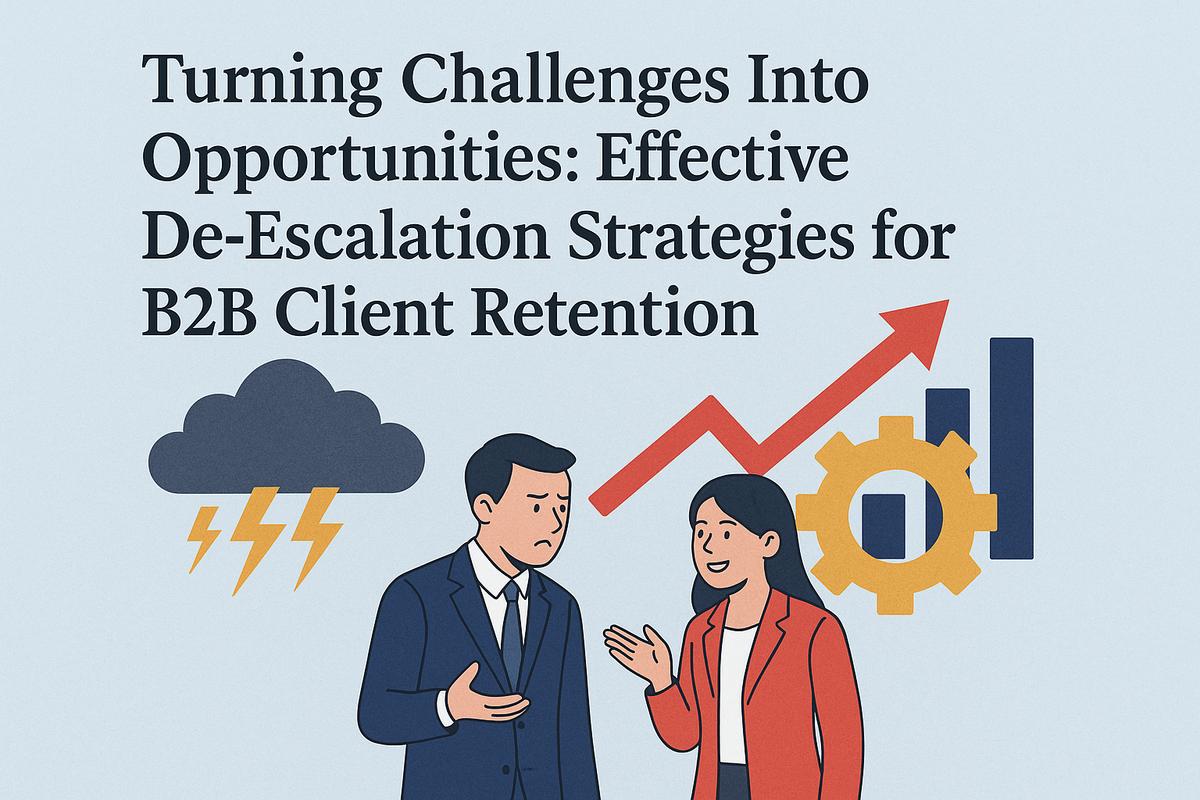Turning Challenges Into Opportunities: Effective De-Escalation Strategies for B2B Client Retention

Do you provide services or products for other businesses? If so, you’ll have to deal with challenges and conflicts from time to time. Even if you have the best client partnership, things can go wrong. Whether due to a miscommunication, disagreement, or unmet expectations, things won’t always go smoothly.
While these situations can be stressful, they also present a valuable opportunity. They give you the chance to turn a potential setback into a moment that strengthens trust and loyalty. When you master the art of de-escalation, you can transform tense interactions into avenues for growth.
Get it right and you stand to improve customer retention and satisfaction.
The Importance of De-Escalation in B2B Relationships
B2B interactions are very different from B2B ones. These relationships are often characterized by:
- Long-term commitments
- High-stakes contracts
- Interdependent workflows.
When there’s a problem in this type of relationship, it affects multiple departments. Therefore, de-escalation isn’t just about resolving the immediate conflict. It’s about preserving the partnership, protecting your reputation, and creating pathways for future success.
Sometimes this means making compromises. That said, it does lead to a stronger overall partnership. When you manage conflicts skillfully, you’ll benefit from:
- Improved trust: Clients expect things to go wrong from time to time. They also expect you to resolve these issues quickly and transparently. By doing so, you’ll reassure your clients that you’re committed to their success. They’re, therefore, more likely to want to help your business.
- Stronger partnerships: Shared problem-solving builds camaraderie and resilience. It also shows customers that you’re willing to work with them to build the relationship.
- Client retention: If you can handle crises effectively, your clients will see you as dependable. They’ll be more likely to stick with your company as a result.
The Top 5 Challenges in B2B Client Relationships
To implement effective de-escalation strategies, it’s crucial to understand the types of challenges that frequently arise in B2B interactions. These include:
- Unmet Expectations: Misaligned goals, unclear deliverables, or differing interpretations of agreements can lead to frustration.
- Communication Breakdowns: Misunderstandings due to poor communication can snowball into significant conflicts.
- Performance Issues: Delays, quality concerns, or system failures can erode trust.
- Changing Client Needs: Shifts in priorities or unforeseen circumstances can create misalignment.
- Budget Constraints: Disputes over costs, billing, or return on investment can strain relationships.
Recognizing these challenges early allows businesses to address them proactively, setting the stage for smoother resolutions.
Principles of Effective De-Escalation
Effective de-escalation is about more than fixing a problem; it’s about creating a sense of collaboration and partnership. Here are some principles to guide your approach:
Empathy is Key
Acknowledge the client’s feelings and validate their concerns. Often, the emotional aspect of a conflict can be more significant than the issue itself. By showing empathy, you demonstrate that you value their perspective and are invested in their success.
Active Listening
Active listening involves not only hearing what the client says but also understanding their underlying concerns. Repeat key points, ask clarifying questions, and avoid interrupting to show you’re fully engaged.
Remain Calm and Professional
Even if the client is frustrated or angry, maintaining a calm and composed demeanor can help de-escalate the situation. Your reaction often sets the tone for the conversation.
Focus on Solutions
Instead of dwelling on the problem, pivot the conversation toward actionable solutions. Collaborate with the client to explore options that address their concerns and align with their goals.
Transparency Builds Trust
Be honest about what went wrong, what you can do to resolve the issue, and what steps you’ll take to prevent recurrence. Transparency fosters trust, even in challenging situations.
Step-by-Step Guide to De-Escalation
Let’s look at how you can de-escalate any situation.
Step 1: Acknowledge and Assess
Begin by acknowledging the client’s concern without defensiveness. Use phrases like:
- “I understand why this is frustrating for you.”
- “Thank you for bringing this to our attention.”
Keep in mind that the idea is to maintain the relationship. At this point you need to convince your client that you understand what they’re feeling. It doesn’t matter, at this point, who is at fault.
Next, assess the situation. Gather all relevant details to understand the scope of the issue. This might involve speaking with your internal teams, reviewing communications, or analyzing performance data.
Step 2: Listen and Validate
Schedule a conversation with the client to hear their perspective. During this discussion:
- Allow them to express their concerns fully.
- Validate their feelings by affirming statements such as, “I can see how this has impacted your timeline, and that’s a valid concern.”
- Take notes to ensure you capture all key points.
Be careful not to make excuses. Your goal is to repair the relationship.
Step 3: Apologize and Take Responsibility
If your company is at fault, offer a genuine apology. Avoid vague statements like, “We’re sorry for any inconvenience.” Instead, be specific and say something like, “I apologize for the delay in delivering the project. We take full responsibility for not meeting the agreed timeline.”
Taking ownership signals accountability and a willingness to make amends. Your client knows that something went wrong, trying to backpedal when you’ve made a mistake will destroy the relationship.
Step 4: Collaborate on Solutions
Invite the client to collaborate on finding a resolution. Ask questions like:
- “What outcome would you consider fair in this situation?”
- “How can we best support you moving forward?”
Offering tailored solutions demonstrates flexibility and a commitment to the client’s success. Your customers will appreciate your willingness to resolve the issue.
Step 5: Follow Through
Once you agree on a solution, act swiftly and update your client regularly. When you give your customer consistent follow-ups, you make them feel valued. This is critical for rebuilding the trust.
Step 6: Learn and Prevent
After resolving the issue, analyze its root cause. How can you stop it from happening again? Now implement measures to prevent recurrence. Share your findings with the client to reinforce your commitment to continuous improvement.
Real-World Examples of Turning Challenges Into Opportunities
So, how does our advice translate in the real world? Let’s look at some examples so you can see them in action.
Example 1: A Missed Deadline
- The Challenge: A B2B software provider missed a key deadline, delaying the client’s product launch.
- De-Escalation Approach: The account manager immediately acknowledged the issue and apologized sincerely. They then arranged an emergency call with the client. After hearing the client’s concerns, they proposed a plan to expedite the remaining work and provided a temporary workaround to minimize downtime.
- Outcome: By taking swift action and keeping the client informed, the software provider not only retained the client but also received a testimonial praising their problem-solving skills.
Example 2: Budget Dispute
- The Challenge: A client challenged an unexpected increase in project costs.
- De-Escalation Approach: The project manager organized a meeting to explain the cost increase in detail. They provided a breakdown of the. additional expenses and why they were incurred. They acknowledged the client’s frustration and offered flexible payment terms to ease the financial burden.
- Outcome: The client appreciated the transparency and agreed to continue the partnership, noting the company’s willingness to accommodate their needs.
Building a Culture of De-Escalation
De-escalation isn’t just a skill—it’s a mindset that should be embedded within your organization. Here’s how to cultivate a culture that prioritizes effective conflict resolution.
Invest in Training
You need to train your team to deal with these situations effectively. You’ll need to help them improve their:
- Communication
- Active listening
- Conflict resolution
- Problem-solving skills
You can create role-playing scenarios to help your employees feel more confident in handling difficult conversations. Not sure how to create realistic training exercises? You can draw on examples from previous customer interactions. Alternatively, you can use generative AI to create realistic scenarios.
Empower Employees
You should your team the authority to make decisions that resolve client concerns quickly. Empowered employees can address issues more efficiently, reducing the likelihood of escalation.
Foster a Feedback Loop
You should encourage clients to share feedback regularly, even outside of formal reviews. Open communication channels help identify potential issues early.
Recognize Successes
You need to celebrate team members who excel at de-escalation. When you recognize their efforts, your reinforce how important this skill is. You’ll also motivate your other employees to follow suit.
Metrics to Measure Success
To gauge the effectiveness of your de-escalation strategies, track these key metrics:
- Client Retention Rate: A high retention rate indicates successful conflict resolution.
- Client Satisfaction Scores: Surveys and feedback can reveal how clients feel about your handling of issues.
- Resolution Time: Faster resolution times often correlate with higher client satisfaction.
- Referrals and Testimonials: Positive feedback from clients is a strong indicator of successful de-escalation.
Turning Challenges Into Growth Opportunities
When you can effectively de-escalate tension, you lay the foundation for a better relationship. You’ll need to listen to your clients and address their concerns with empathy. From there, you can collaborate on solutions, compromising where possible.
When you get this right, you can strengthen your partnership and enhance your company’s reputation. You’re not looking to simply resolve conflicts. You want to turn a challenge into a chance to deepen trust.
Mastering de-escalation strategies gives you a business advantage. It’s like making an investment in thriving in today’s competitive landscape.




